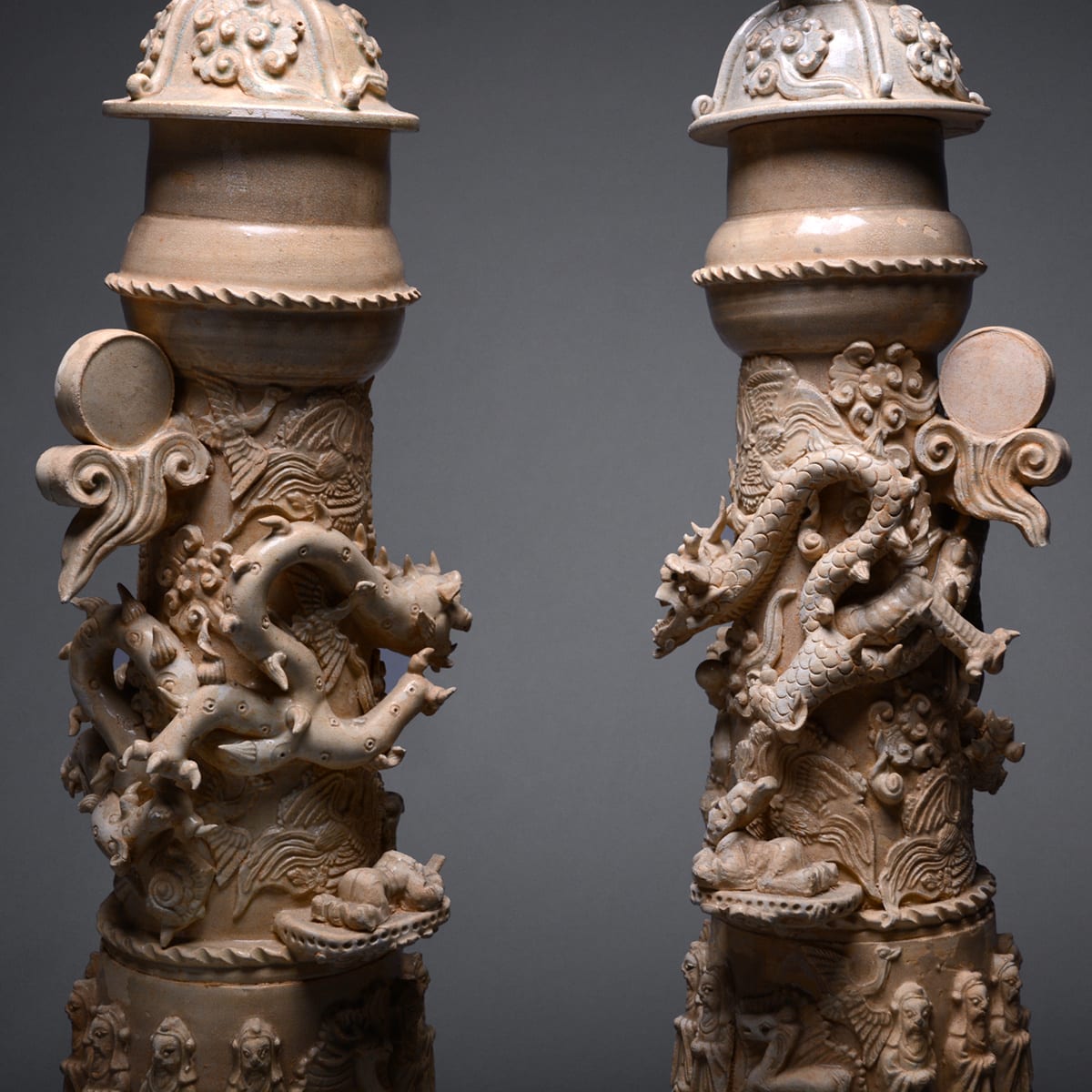Pair of Late Southern Song Lidded Funerary Urns (Ping) with Cranes and Dragons, 1200 CE - 1279 CE
Glazed Terracotta
89.5 x 16.5 cm
35 1/4 x 6 1/2 in
35 1/4 x 6 1/2 in
CK.0149
Further images
This dynamic pair of matched vases is a supreme masterwork from the Southern Song dynasty. They are very tall and graceful, with the widest section in the bottom one third...
This dynamic pair of matched vases is a supreme masterwork from the Southern Song dynasty. They are very tall and graceful, with the widest section in the bottom one third of their total height. They then taper progressively to the top one third, where they flare again to a rather wider apex, crowned with extremely ornate lids, each bearing a crane with outstretched wings. The bottom third is banded with fine lines above a small, plain pedestal base. A ring of roped beading separates this from a line of standing court officials, interspersed with animals such as deer. Above this is a taller section, liberally decorated with floral motifs and featuring a long and highly complex dragon – and an accompanying lotus flower (?) – rendered in very high relief. The entirety is decorated with transparent glaze over a cream/yellow slip.
The Song Dynasty was founded after the fall of the Tang Dynasty and a period of major social unrest. Perhaps because of this, it is viewed as a Golden Age for Chinese civilization. It was also highly complex, as different areas of China were ruled by different dynasties and traditions. The Northern Song was founded in 960 AD, and quickly developed art styles and social changes that were remarkable for their liberalism. Many of China’s greatest landscape painters, sculptors and ceramicists worked during their supremacy, while literary achievements – notably translation of ancient texts and a revival of Confucianism – also benefitted from enlightened leadership. Foreign trade also flourished, leading to major networks of luxury goods running to and from China. However, the stability was threatened by the invasion – in 1125 AD – of Northern China by the Jurchen, a semi-nomadic people from the steppe area. The validated their leadership by founding the Jin Dynasty, although the Song court – who had fled to Hangzhou in the South – continued to govern their area for another 120 years. The Southern Song eventually collapsed due to a combination of internal intrigue and invasion by the Mongols in 1279 AD.
The Song Dynasty is considered to be the golden age of Chinese ceramics, for mass production was perfected, leading to an explosion of different styles and traditions. The elite ceramicists became ever more adventurous, producing remarkable creations for a native class of aristocrats. the ruling elite, high-ranking government officials and wealthy merchants. Technical innovations led to breakthroughs in the fields of glazing and firing, culminating in the first true porcelain to be produced in any significant quantity.
Known as Qingbai ware (also called Yingqing ware), this distinctive, blue- glazed, thinly wheel-thrown stoneware with moulded and applied decoration was produced mainly in Jiangxi province at Jingdezhen and in the Hebei province. Qingbai ware continued to be made well into the Ming Dynasty, with Jingdezhen remaining as an important production centre.
This outstanding pair of vessels was made towards the end of the Song Dynast, in retreat in to the South, and is a major masterwork of ancient China.
The Song Dynasty was founded after the fall of the Tang Dynasty and a period of major social unrest. Perhaps because of this, it is viewed as a Golden Age for Chinese civilization. It was also highly complex, as different areas of China were ruled by different dynasties and traditions. The Northern Song was founded in 960 AD, and quickly developed art styles and social changes that were remarkable for their liberalism. Many of China’s greatest landscape painters, sculptors and ceramicists worked during their supremacy, while literary achievements – notably translation of ancient texts and a revival of Confucianism – also benefitted from enlightened leadership. Foreign trade also flourished, leading to major networks of luxury goods running to and from China. However, the stability was threatened by the invasion – in 1125 AD – of Northern China by the Jurchen, a semi-nomadic people from the steppe area. The validated their leadership by founding the Jin Dynasty, although the Song court – who had fled to Hangzhou in the South – continued to govern their area for another 120 years. The Southern Song eventually collapsed due to a combination of internal intrigue and invasion by the Mongols in 1279 AD.
The Song Dynasty is considered to be the golden age of Chinese ceramics, for mass production was perfected, leading to an explosion of different styles and traditions. The elite ceramicists became ever more adventurous, producing remarkable creations for a native class of aristocrats. the ruling elite, high-ranking government officials and wealthy merchants. Technical innovations led to breakthroughs in the fields of glazing and firing, culminating in the first true porcelain to be produced in any significant quantity.
Known as Qingbai ware (also called Yingqing ware), this distinctive, blue- glazed, thinly wheel-thrown stoneware with moulded and applied decoration was produced mainly in Jiangxi province at Jingdezhen and in the Hebei province. Qingbai ware continued to be made well into the Ming Dynasty, with Jingdezhen remaining as an important production centre.
This outstanding pair of vessels was made towards the end of the Song Dynast, in retreat in to the South, and is a major masterwork of ancient China.







